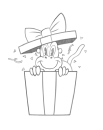This project is from my Drawing Basics course and I’m releasing this one as a sample to show you kinda what you get in a typical project in that course. This project focuses on showing you some games you can play to improve your visual memory. A good visual memory will help you with drawing from imagination, speed, creativity, and observational skills.
Check out these free Loomis Head lessons:
How to Draw the Head from Any Angle
Quickly Draw Heads with the Loomis Method – Part 1
Draw ANY Head Type with the Loomis Method – Part 2
Intuitive Portrait Sketching with the Loomis Method – Part 3
For this project, you'll have several exercises/challenges/games to choose from to help improve your visual memory.
Game 1 - From Memory
The first game is to draw from memory. Start by just looking at it for a minute or two. Study it and try to remember as much as you can about it. Then hide your reference and draw as much as you can from memory. After you’re done, bring back your reference and check your accuracy. For extra credit you can try again to see if you can do better the second time.
Game 2 - Change Angle
Look at something and draw it from a different angle. You don’t have to hide the reference for this one. Just trying to imagine it from a different angle is enough to improve your ability to visualize.
Game 3 - Combine Them!
Again, start by looking at it for a few minutes, then draw it from memory and from a different angle.
OR.. you can make it a little easier by starting with a study drawing. Draw it as you see it, then put all that away and draw it from memory from a different angle. That initial drawing helps you learn the construction of the forms and remember a little better than just looking at it.
Game 4 - Change Proportions
This next one is only for level 2. Drawing from a figure reference, draw from a different angle (from memory) AND change the proportions. You’re using the reference as inspiration to redesign and create your own thing.
Game 5 - Moving Subject (Bonus)
Bonus - this one’s not part of this assignment but I'm just throwing it in here because you should try it on your own at some point. And that is, drawing from a moving subject. For example if you go to the zoo, some animals are just sitting around or sleeping, but others are constantly moving. So you start by watching it for a few minutes, figure out the basic forms, and then take a snapshot in your mind of a pose you see as it’s moving. Then you draw it. As you’re drawing it, the animal is still there to help you with the proportions and a reminder of the basic forms, but the pose will have to be from memory. Occasionally if you get lucky, you’ll see that pose again. It’s a very challenging but fun exercise that forces you to work with what you’ve got.
Level 1
You’re going to be drawing from 3D models that I’ve provided as the next 8 lessons in the playlist.
For each 3D model, you can pick the game you want to try from the first 3.
- Draw it from memory
- Draw from a different angle.
- Combine them
And for this project, make sure that you're focused on practicing perspective. Construct them using simple primitives.
The benefit of doing these from a 3D model is that if you’re drawing it from a different angle, you can then change the angle to the one you drew to actually get instant feedback on how you did. But, keep in mind it’s not meant to be done perfectly. It’s meant to challenge you and help you get better at visualizing 3d forms in your head. When you rotate the model to check yourself, if it’s not exactly right, that’s fine. Just take the feedback and do another one.
Level 2
You’re going to be drawing the figure from the reference models that I’ve provided in the downloads tab (they are the same images as the previous project).
Choose one of the 4 games (don’t forget that changing proportions is another option) and you’re going to simplify those poses to a mannequin.
- You can use the gestural torso boxes from the previous project.
- Attach cylinders for the limbs and neck
- The head can be a loomis head.. If you’re not sure what that is you can watch my free videos from a while back (I’ll leave some links below), OR you can just use a simple sphere or box, like we did before.
- You can choose how simple you make the hands and feet.
Check out these free Loomis Head lessons:
How to Draw the Head from Any Angle
Quickly Draw Heads with the Loomis Method – Part 1
Draw ANY Head Type with the Loomis Method – Part 2
Intuitive Portrait Sketching with the Loomis Method – Part 3
Deadline - submit by August 16, 2024 for a chance to be in the critique video!
































